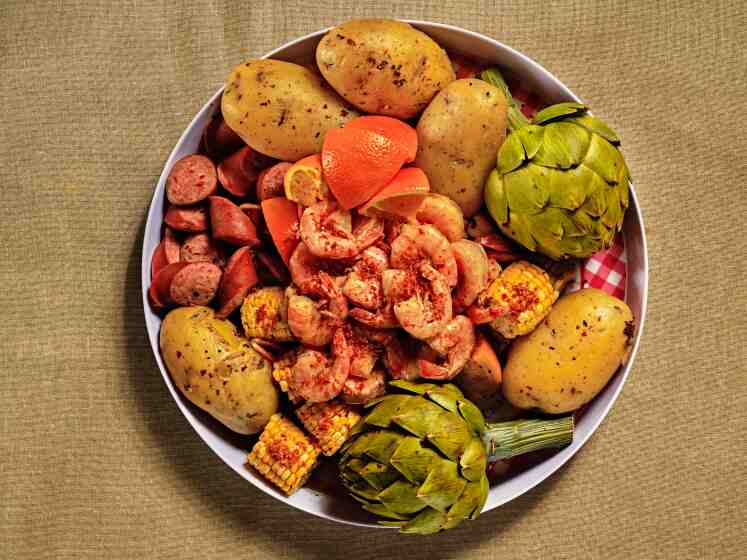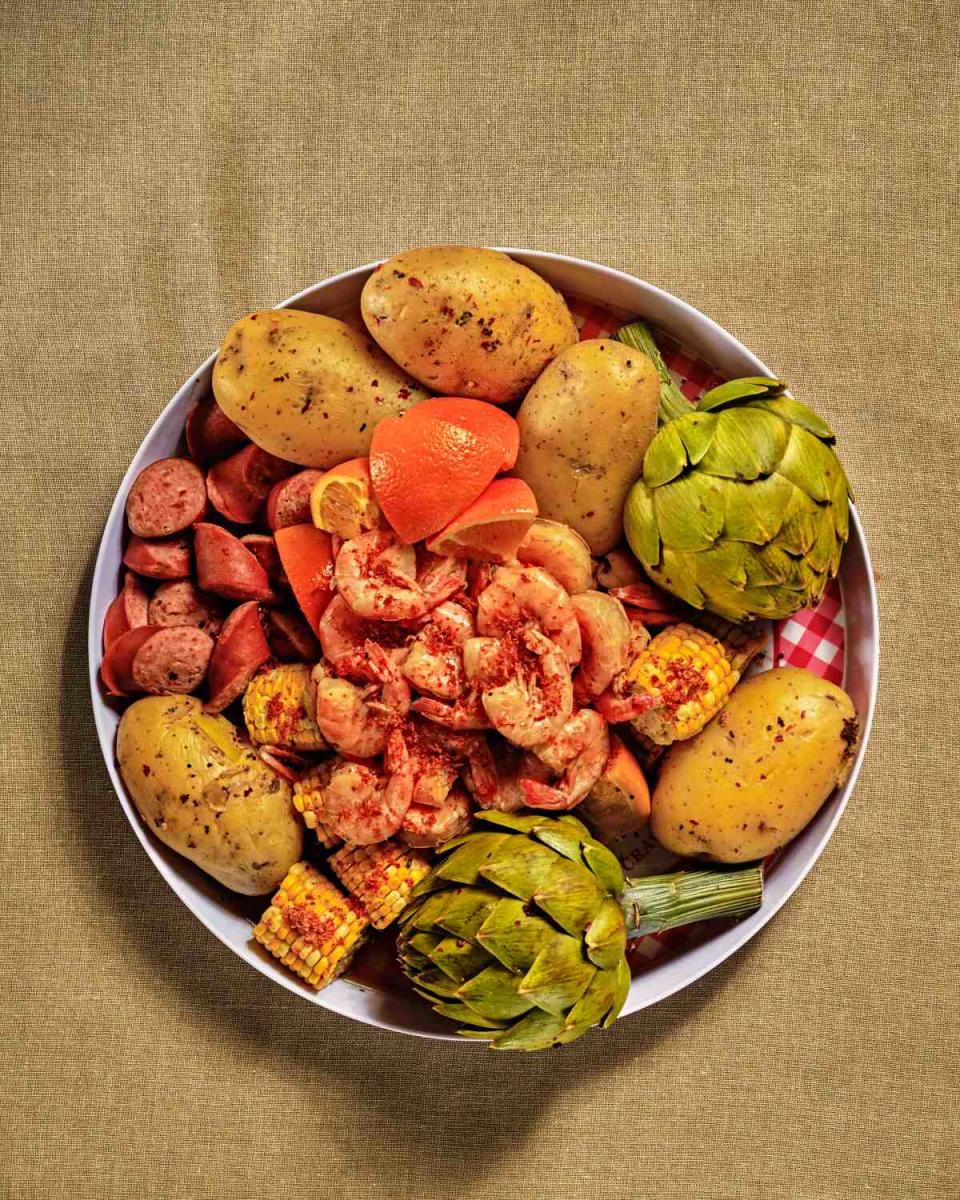A Southern spring staple with notes of Sicily and SoCal

Springtime nostalgia hits everyone differently. For some, seeing the first stalks of asparagus or baby artichokes at the market marks the epitome of the season. For others, it might be sneezing from allergies. For me, however, the thing that feels the most like spring is the smell of boiling seafood.
Growing up in Mississippi — a state whose food is influenced heavily by neighboring Louisiana — we’d often have crawfish boils in the spring, just like most people do in the Pelican State. Crawfish are big in springtime because they thrive in the freshwater ponds that grow rice all across the South. Once those fields are drained come spring, the crawfish are fully mature and meaty. The fact that this lines up with the Lenten season means there’s big demand for the locally plentiful seafood.
Seafood boils of all kinds are a pretty universal experience elsewhere in the U.S. if you live near the ocean. Blue crab boils in Maryland, Dungeness crabs in the Pacific Northwest, lobsters and clams in New England, and in Southern California, wild shrimp are plentiful, so when I cook a boil here, that’s what I use.
The thing about seafood boils, though no one really ever talks about it, is that it’s really difficult to get a lot of flavor into the actual ingredients because of the amount of water needed to cook everything in such a large batch. Besides a sometimes overwhelming chile heat — the primary flavoring in a Cajun crawfish boil — the rest of the flavors are somewhat, well, diluted. And to get a lot of flavor pumped into the water, you end up having to use industrial products with names like “pro-boil” that, with ingredient lists containing various concentrates, extracts and dyes, read like they belong in the cleaning aisle of the grocery store.
Typically, besides the actual crawfish, the only other truly seasonal ingredient involved in a crawfish boil is new potatoes, but you can also use any spud. Corn and fresh sausages are added to the mix, and everything is sent toppling in a bathtub-full amount of water in a giant cauldron set atop industrial-strength propane burners. Chiles and aromatics are tossed in to steep their flavor into the primordial soup so that, when the crawfish are added, they will soak up the spice as they cook.
But since I wasn’t able to have a crawfish boil this year and still wanted to re-create that experience at home here in Los Angeles, I developed a seafood boil using shrimp — probably the easiest seafood for anyone to procure no matter where you live — that is manageable in a small apartment kitchen and with no outdoor space. Doing this, contrary to what you might think, actually made my seafood boil better.
For starters, I can pay attention to each ingredient individually, cooking it to the proper doneness. Typically in these types of seafood boils, everything kind of boils together for an indeterminate amount of time, and by the time everyone at the party has had a few beers, I suppose they don’t really notice a difference. But at home and for entertaining small groups of guests, those details become the priority so that each ingredient can be appreciated by its own merits — and not what it was boiled next to for hours. So I boil all the ingredients more or less individually so I can cook them to the best quality.
I start with the biggest pot I own, a 7 1/4-quart Dutch oven. Most pots you’d boil pasta in are the same size or bigger, so I guarantee you own something large enough to get the job done. To the pot of water, I add spices that are included in the Zatarain’s “Crawfish, Shrimp & Crab Boil” mix. Chile flakes, mustard seeds, bay leaves and coriander all mingle together in the water to lend their aroma to the bubbling tea.

The first ingredient to go in is the potatoes. I actually prefer large Yukon Gold potatoes for two reasons. One, their skin is more tender than a russet. And two, each person gets to have their own large potato to use as more or less the “bland” component in the boil — something to reach for when you need a respite from all the other more spice-soaked ingredients. Once they’re done, I lift them from the pot and keep them warm in the oven.
Next go in two ingredients most probably would never associate with a seafood boil: oranges and artichokes. My cousin Vic Caracci lives in New Orleans and has Sicilian heritage on his father’s side. If you know cuisine from the Crescent City, you know it’s heavily influenced by the volcanic Italian island at the tip of the "boot." So many Italian ingredients make their way into his otherwise classic “New Orleans” cooking. Case in point: He adds whole artichokes to his crawfish boil so you can pick off the leaves and scrape them through your teeth as you eat, picking up all the jus from the seafood and spices. And oranges are added for their brightness and bittersweetness, which balance the heavily spiced broth. There’s a symbiosis in those ingredients with spring in California, too, that I adore.
After the artichokes and oranges infuse the potlikker with their essence, in go the corn and sausages. Typically, the sausages are fresh and of the mild Italian variety. But here’s where I’m making my own change. I prefer cured sausages like kielbasa or bratwurst because they only need to be warmed up and not cooked through, which in fresh sausages often leads to overcooked or undercooked meat, and rarely the perfect median. And though you might think andouille would be more appropriate in a Cajun-style seafood boil, you don’t want to use it. The spicy broth and seafood will be hot enough; you want the sausages, like the potatoes, to give you a respite from all that fire.
Finally, in go the shrimp. You can obviously use expensive head-on prawns, but I actually prefer wild-caught shrimp tails, either with the peel on or not, but definitely deveined. The shrimp go into the broth after it’s had a full hour of picking up flavors from the rest of the ingredients, and they steep in the broth until perfectly cooked.
Everything then gets piled onto a giant platter and sprinkled with an aggressive seasoning mix to really nail home the flavor that gets watered down in the broth. I combine Lawry's seasoned salt — a hometown L.A. staple — with paprika, cayenne, a little sugar and then lots of lemon zest for brightness. Mixed together, the spices add a punch to the boil while complementing the sweetness of the corn and shrimp and the acidity of the oranges.
Plop the platter in the center of your table, reject any flatware and pile damp paper towels by each diner to use for wiping their hands between bites. With a cold beer or glass of wine at the ready, it’s the quintessential spring occasion, no matter if you're sitting at an apartment dining table, a patio picnic table in the backyard, or 1,900 miles away from where it started in spring, all those years ago.
Get the recipe:
This story originally appeared in Los Angeles Times.

